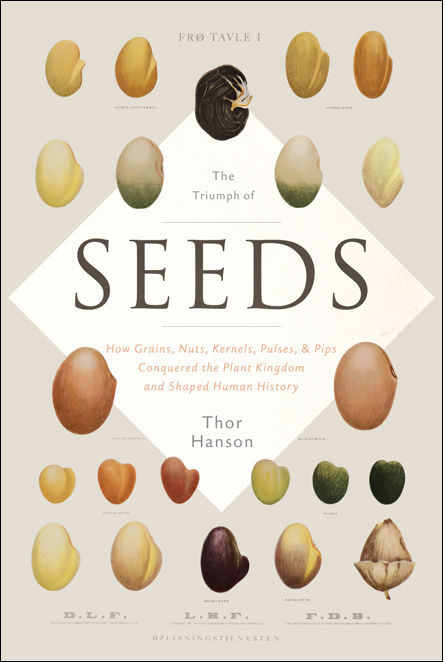
The Triumph of Seeds
How Grains, Nuts, Kernels, Pulses, and Pips Conquered the Plant Kingdom and Shaped Human History
کتاب های مرتبط
- اطلاعات
- نقد و بررسی
- دیدگاه کاربران
نقد و بررسی

February 1, 2015
"From tropical rain forests to alpine meadows and arctic tundra, seed plants dominate landscapes and define ecosystems." In fact, they make up more than 90 percent of land flora.Having caught our attention, conservation biologist Hanson (Feathers: The Evolution of a Natural Miracle, 2011) proceeds to tell how this happened. Traveling the world to interview experts without ignoring his own research, the author writes a delightful account of the origins, physiologies and human uses of a vast variety of objects that plants employ to make more plants. Long ago, ferns and mosses covered the Earth and reproduced by releasing clouds of tiny spores. These days, we encounter them as coal plus a scattering of survivors. Far more robust than spores, seeds are a dazzling evolutionary triumph with, Hanson stresses, five distinct qualities. They nourish a plant's early life with either starch (grasses, grains) or fat and protein (nuts, legumes, beans). Humans have co-opted these nutrients as the foundation of our diet; modern civilization requires them. They unite. Seeds are the product of sexual reproduction, an enormous, creative evolutionary advance. They endure from months to decades, waiting for the right combination of elements to trigger germination. Centuries ago, human manipulation of dormant seeds made agriculture possible. They defend the embryonic plant with shells, husks, rinds and chemicals. Humans convert these to pharmaceuticals, enjoy them in a variety of applications (caffeine, peppers, chocolate) and sometimes get sick from them (hemlock, strychnine). Finally, seeds travel. Whether by wind or water or the guts of animals that eat them, this allows plants and the humans that follow them to occupy every habitat on Earth. "[F]or all the fascinating tales of seeds in nature," writes Hanson, "one of their hallmarks is that we don't have to look far to find them." A fine addition to the single-issue science genre.
COPYRIGHT(2015) Kirkus Reviews, ALL RIGHTS RESERVED.

March 1, 2015
Conservation biologist Hanson's new book showcases an even more approachable style than his 2011 Feathers. Using a personalized viewpoint derived from his backyard lab and dissertation research in Costa Rica with the almendro tree, as well as visits with specialists worldwide, he describes how seeds nourish, unite, endure, defend, and travel. What is a seed? A potential baby plant with a protective coat and food to start growing. With that in mind, and a little humor, the author includes paleontology, evolution, a 2,000-year-old seed that grew a tree called Methuselah, seed banks and botanical gardens, and seeds that are both useful to and harmful to humans. He discusses seeds' shapes and sizes; how they are distributed by water, air, animals, and birds; how they inspire us (think flight); and how they protect themselves. Jane Goodall's recent Seeds of Hope has a chapter on seeds and mentions some of the same items found here, but Hanson's work also includes a solid glossary and bibliography that are not offered in Goodall's title. VERDICT Recommended for gardeners and readers of natural history and history of science.--Jean E. Crampon, Univ. of Southern California, Los Angeles, Lib.
Copyright 2015 Library Journal, LLC Used with permission.

Starred review from February 15, 2015
Conservation biologist Hanson follows Feathers (2011) with a book inspired, in part, by his young son's preternatural fascination with seeds. Jocular and entertaining in his dispensing of remarkable facts about these little vessels of life-to-be, Hanson shares tales of his Central American field work (snakes and all) studying the stone-hard almendo seed, which grows into a long-lived, 150-foot, rain forest giant supporting an entire, seething ecosystem. This inspires Hanson to vividly describe the evolutionary virtual arms race between seeds and seed-eaters. As he visits with seed experts around the world, Hanson marvels over the amazing energetics of seeds, the evolutionary impact of our ancestors' consumption of seeds, especially cooked grains, and the civilization-shaping political power of grain. He also chronicles the global impact of coffee and chili peppers and seeds' capacity for dormancy, including one excavated 2000-year-old date palm seed that grew into a 10-foot tree in Israel. From high-tech, high-security seed banks bracing for climate change to the story of the gum extracted from guar seeds that is used in everything from ice cream to fracking, this upbeat and mind-expanding celebration of the might of seeds is popular science writing as its finest.(Reprinted with permission of Booklist, copyright 2015, American Library Association.)

























دیدگاه کاربران